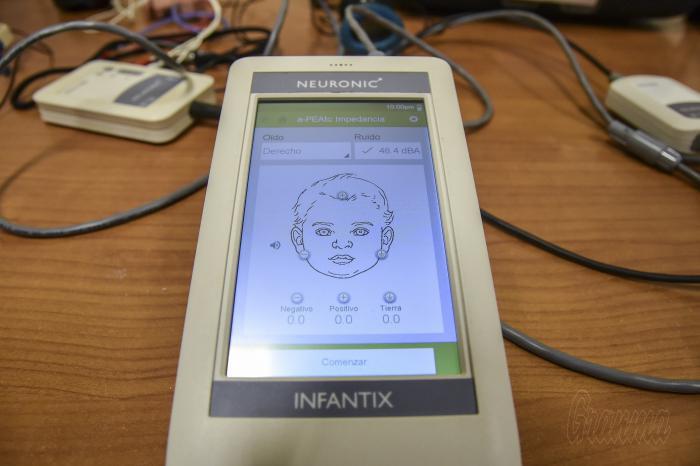
Cuban-made Screening System Created for our Children
According to several scientific studies, the baby's auditory system, even before birth, is capable of responding to the noises it perceives in the mother's womb. Of all the senses, hearing is, fundamentally, the sensory experience that facilitates communication and promotes social interaction, thus being an essential aspect in the emotional and cognitive development of people.
Hence, hearing loss is an obstacle to education and social integration, especially if it is not diagnosed in the first months of life.
The World Health Organization estimates that, in childhood, almost 60% of cases of hearing loss are due to preventable causes, while diagnostic tests allow these conditions to be detected at the earliest possible stage.
"Research on the matter agrees that children who are born deaf or suffer a hearing loss, but are the object of appropriate interventions within the first six months of life, have acquired the same cognitive skills by the age of five as those with normal hearing ability.
"The purpose of Infantix -a neonatal screening system developed by the Cuban Center for Neurosciences (Cneuro)- is aimed precisely in that direction: early detection of hearing and vision disorders in infants," Ernesto Velarde Reyes, a telecommunications engineer and one of the leaders of the project, explained to Granma.
In Cuba's maternity hospitals, he said, it is common for this type of hearing test to be performed on newborns and, for this purpose, acoustic otoemission equipment, which is imported into the country, is frequently used. However, none of these technologies in the world has incorporated visual screening among its functions; the Infantix has, he pointed out.
Another feature of this Cuban-made tool is that it has a system designed to couple different modules, depending on the test and the signal registers.
For example, he pointed out, for otoacoustic emission tests, the module comes equipped with an attachment that has microphones and speakers, taking into account that the clinical analysis consists of the device emitting a sound and picking up its echo. In this "rebound" there is information on the functioning of the entire middle and inner ear, and based on this data, the Infantix performs an analysis and dictates a result, explained Velarde Reyes.
In the case of a visual evoked potential, he added, the patient receives a visual stimulus, a flash, and our screening system evaluates the brain's response to that stimulation. "In this way, we can measure from the retina, the optic nerve, to the part of the brain cortex that is in charge of visual processing.
According to the specialist, this type of research can detect major visual pathway problems such as congenital cataracts or neuropathies of the visual nerve.
"In both visual and auditory evoked potentials, if the device detects any anomaly, it will indicate that the patient should be referred, either to repeat the test in the coming weeks or to be attended directly by specialists; otherwise, it will indicate that the infant passed the test without any problems.
The main purpose of our work, he said, is to detect any hearing or visual ailment as early as possible; and in the specific case of hearing, the objective is that every newborn leaves the hospital with this test performed.
This goal, he explained, is conditioned by the fact that, as of six months of age, the areas related to language begin to form in the cerebral cortex. "If we are able to diagnose any problem prematurely and refer for specialized care, this patient will have a normal development throughout his or her life.
From "Lab" to practice
In February 2019, Infantix obtained registration from the Center for State Control of Drugs, Equipment and Medical Devices to perform auditory screening, while the visual analysis method was registered in April 2020.
According to Velarde Reyes, the Ministry of Public Health is currently working on a national plan to introduce this equipment in health institutions and, although the situation caused by COVID-19 has delayed its implementation, the prospect is that a device will be available in each maternity ward.
The main tests, he added, have been carried out at the Ramón González Coro Gynecobstetric Hospital in Havana, and we have also had the assistance of other institutions and self-employed workers, especially in everything related to technical printing and 3D modeling.
As part of the project's sustainability and the incorporation of new facilities, the specialist indicated that they are working on adding a cardiovascular research module to the equipment, which would undoubtedly provide another added value, since it would allow determining whether there are alterations in the function of the cardiovascular system.
Another of the singularities of Infantix, he pointed out, is that it does not require technical personnel to operate it or read the results. It is an intelligent system, with automatic analysis and processing methods, and a user-friendly interface that is easy to interact with, he said.
"It also incorporates our own methods, developed by Cneuro, which gives us a certain technological independence, since there is no need to import the systems."
(Taken from Granma)